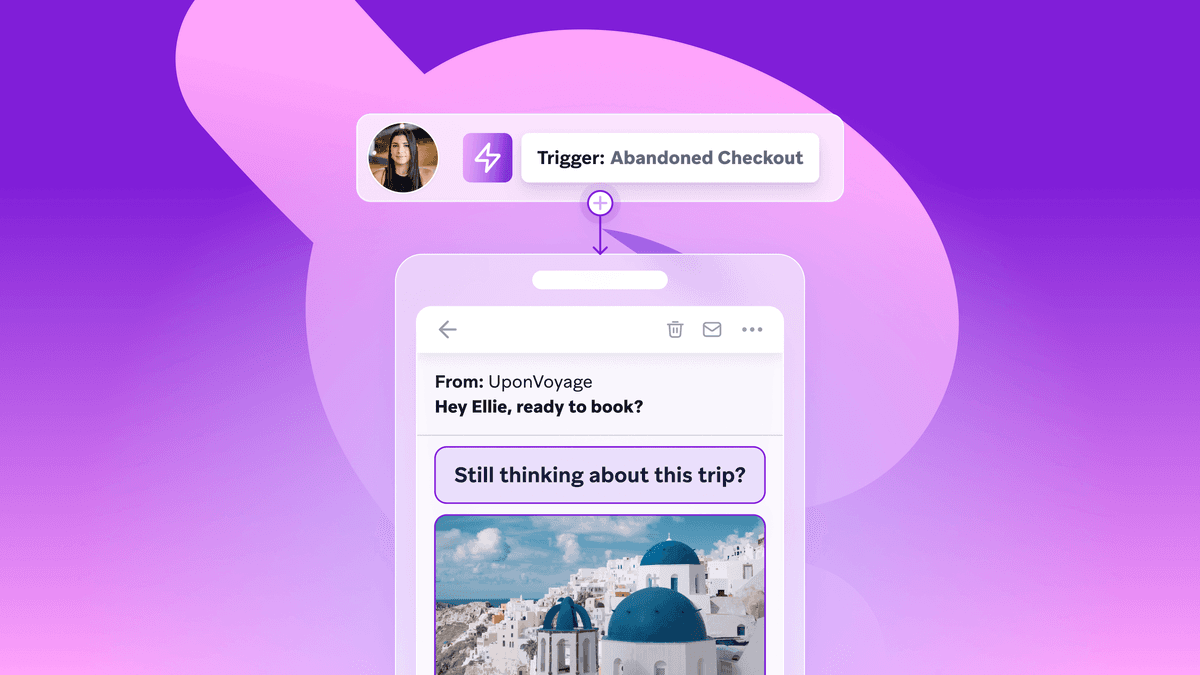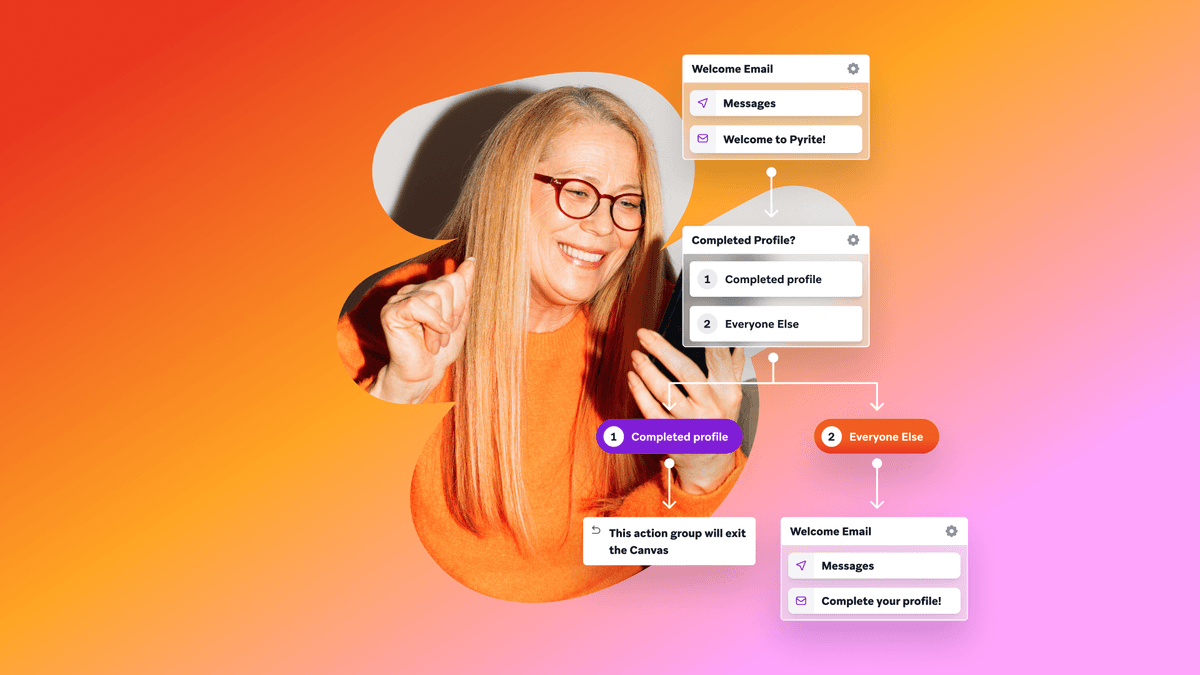Published on April 29, 2025/Last edited on April 29, 2025/15 min read


The expectations for mobile messaging is high—and climbing. Consumers want brands to be relevant, responsive, and right there when it matters. But keeping up with that level of demand can be hard, especially when your team is already juggling multiple goals, plans, and priorities.
That’s where mobile marketing automation comes in. It’s not just about sending messages at scale—it’s about building smart, personalized ways to connect that feel intuitive to the user and effortless for your team. In this guide, we’ll walk through what mobile marketing automation is, how it works, and why it’s become essential for modern app strategies.
From smarter segmentation to seamless cross-channel customer journeys, here’s how automation can help you stay one step ahead—without losing the human touch.
Contents
Mobile marketing automation is the practice of using software to automate timely, personalized messages to app users at scale. These messages can be triggered by user behavior, preferences, or lifecycle stages, and sent via channels like push notifications, in-app messages, SMS, and more. The goal is to create seamless, relevant brand experiences that keep users engaged—without relying on manual work from marketers to do so.
Instead of manually segmenting lists and scheduling individual sends, marketers can create workflows that automatically respond to what users are doing in the moment, whether that’s launching the app for the first time, abandoning a cart, or going quiet after a period of activity.
Mobile marketing automation sits at the heart of modern app strategies. It allows teams to scale their efforts while maintaining a human touch with the consistency users have come to expect from leading mobile brands.
For brands with a mobile app, this kind of automation offers more than just efficiency. It creates the foundation for smarter, more responsive customer experiences—without putting pressure on already stretched marketing teams.
With automation tools, messages aren’t just sent—they’re triggered. That means your outreach aligns with what consumers are doing right now, not what they did last week. Whether it’s welcoming new users, prompting a purchase, or re-engaging someone who’s gone quiet, automated flows help deliver the right message when it’s ready to be heard.
You can use data like user behavior, preferences and demographics to dynamically personalize your automated campaigns For example, brands can tailor messages based on a consumer’s app activity, purchase history, location, and more, helping each communication feel unique to each user.

You can orchestrate automated campaigns across push, in-app, SMS, and beyond. This consistency helps users stay connected to your brand, no matter where or how they engage.
Once your workflows are in place, they run in the background—freeing your team to focus on strategy, testing, and creative. It helps to reduce manual effort and gives marketers more time to iterate and optimize.
By staying relevant and responsive throughout the customer journey, automated campaigns help build long-term loyalty. Whether it’s nudging a dormant user or recognizing a high-value one, automation helps brands stay one step ahead.
Mobile marketing automation can take many forms, depending on the message, the moment, and the channel. The most effective strategies combine several types, building a coordinated experience that feels intuitive to the user.
These are automated messages that respond to user actions—or inaction. Examples include:
Because these messages are tied directly to user behavior, they tend to feel relevant and well-timed.
This type of automation supports users as they move through different stages of their journey—from onboarding to retention to reactivation. Brands often build out entire lifecycle flows that adjust based on how engaged a user is, what they’ve interacted with, or whether they’re likely to churn.
Each mobile channel has its own strengths. Automation helps brands tap into those strengths at scale:
Strong automation starts with intent. Before building workflows, brands need a clear sense of what they want to achieve, who they’re speaking to, and how mobile fits into the broader marketing picture.
The right automation setup depends on what you're aiming for. Are you looking to boost activation rates? Increase repeat purchases? Reduce churn? Mapping your goals to specific user actions helps you design workflows that are targeted and measurable from day one.
Each user journey can be different. New users might need education and encouragement. Power users might need rewards or product updates. Lapsing users might need reminders or incentives to return. Grouping users into lifecycle stages—and understanding what motivates each group—will help you tailor your automation flows more effectively.
Additionally, once you get to know your users over time, you can discover specific segments (based on behavior, likes, etc.) to create messaging for.
Identify the high-impact points in the journey where automation can make a difference. These might include:
Focusing on these moments helps keep your messaging relevant and purposeful, rather than overwhelming.
The Braze Inspiration Guide is here to help. This collection of 50 inspirational use cases can be easily customized to fit your unique needs and address your unique challenges.
Mobile users don’t stay in one place, so your strategy shouldn’t either. Coordinate push, in-app, SMS, email campaigns, and even channels like WhatsApp to create connected journeys that respond to user context. For example, a push notification might lead someone back into the app, where they receive an in-app message guiding them to take the next step.
A good strategy isn’t static. Use campaign results and performance data to refine your flows over time. Small changes—like message timing, wording, or design—can have a big impact when they’re based on solid insight. You can also discover what’s not working and how to fix it.
This kind of intentional planning sets the stage for automation that supports both your users and your business.
Once you’ve laid the strategic groundwork, it’s time to bring your automation plans to life. That means building out message flows, defining triggers, choosing channels, and optimizing content—all in a way that feels smooth and human, not robotic or repetitive.
Mobile marketing automation works best when it’s part of an ongoing, responsive relationship with consumers. The technology enables scale, but what matters is how you use it to add value to your users.
The most successful brands don’t just automate for the sake of it—they build thoughtful, user-centered experiences. Here are some practices that help teams get more from their automation:
Automation should serve the user experience, not interrupt it. Focus on helpful, relevant messaging that solves problems or adds value.
Leverage data like session frequency, in-app actions, and purchasing behavior to tailor your messages. For example, if a user frequently engages with a specific feature, your automation can highlight new ways to use it.
Sending too many messages—especially across multiple channels—can fatigue users. Use frequency capping and channel prioritization to avoid overwhelming people.
A/B and multivariate testing helps refine what works. Make experimentation part of your process.
Think about which channels best fit the message and moment. For example, a transactional message might work best over SMS, while a deeper onboarding sequence could play out across in-app and email.
This guide shows you how to build the right channel mix to hit your customer engagement goals—like driving up to 88.3X more purchases per user with a coordinated push, in-app message, email, and SMS strategy.
Automation supports a wide range of campaigns throughout the user lifecycle. Here are some of examples of effective use cases:
Automation allows these campaigns to run consistently in the background as well as adapt as users grow, giving each persona a journey that feels custom-built to them.
Brands that use mobile marketing automation platforms maximize their marketing efforts and the following case studies are perfect examples of the many ways this can play out.
Dutch Bros is a popular drive-thru coffee chain with a cult following and a strong mobile presence. As a brand focused on community, Dutch Bros wanted to create a year-end campaign that felt personal, fun, and shareable.
With a rapidly growing customer base, Dutch Bros needed a way to deliver individualized messages at scale—without sacrificing the friendly, feel-good tone the brand is known for.
Using Braze, Dutch Bros created a year-in-review campaign that tapped into user data to highlight personalized stats, like total drinks purchased. The messages were sent via in-app messages, Content Cards, and push notifications, using automation to tailor the experience for each user.

The campaign drove strong re-engagement and social sharing, showing how automated personalization can deliver delight at scale—while reinforcing loyalty.
KFC Ecuador, with 148 locations nationwide, is a leading quick-service restaurant (QSR) brand known for its finger-lickin' good chicken. To maintain a competitive edge, the company sought innovative ways to engage customers between visits.
Despite a strong customer base, KFC Ecuador noticed a significant number of mobile app users were downloading coupons but not redeeming them. This gap indicated missed opportunities for both customer engagement and sales.

Leveraging the Braze Intelligence Suite and Canvas, our no-code customer journey builder, KFC Ecuador designed targeted campaigns to address the issue. They tested value-added offers like free delivery or complimentary menu items, using Intelligent Timing to send messages when customers were most likely to engage. The campaigns were delivered through both email and push notifications to determine the most effective channel for re-engagement.
By implementing these personalized, timely messages, KFC Ecuador achieved a 15% increase in revenue. This approach not only reduced the number of abandoned coupons but also provided deeper insights into customer behavior, enabling more effective future marketing strategies.
Quizlet, a leading online learning platform, offers tools like flashcards and games to help students and teachers worldwide. With 60 million monthly users, Quizlet aimed to enhance user engagement by encouraging consistent study habits.
Quizlet wanted to motivate users to engage with the platform regularly by tracking and promoting study streaks—consecutive days or weeks of activity. However, their existing CRM platform required engineering support for campaign adjustments and lacked robust targeting and filtering tools.
By implementing Braze Canvas, Quizlet designed a cross-channel campaign that utilized email, in-app messages, push notifications, and Content Cards to promote and maintain user streaks. They used webhooks to update streak counts and employed Intelligent Timing to send messages during when users where most likely to engage.

This strategic approach led to a 42% conversion rate, with Braze Canvases entered over a billion times, driving 4.6 million sessions. By gamifying the learning experience and personalizing communication, Quizlet successfully fostered better study habits and increased platform engagement.
Max (formerly HBO Max), a direct-to-consumer streaming platform under Warner Bros. Discovery, offers a diverse catalog of high-quality entertainment.
With the release of Fantastic Beasts: The Secrets of Dumbledore, Max aimed to captivate the Wizarding World fanbase and enhance viewer engagement by delivering personalized content that resonated with fans' interests.
Utilizing Canvas, our no-code customer journey orchestration tool, Max implemented a "What's Your Hogwarts House?" in-app survey to collect zero-party data, or data directly from users. Based on their house selection, users received personalized emails or push notifications featuring their name embedded on their house crest, along with curated content recommendations aligned with their house traits. This strategy provided an engaging, tailored experience that deepened user involvement.

This interactive, cross-channel campaign led to:
By creatively engaging fans with personalized content, Max successfully boosted viewer engagement and plans to replicate this strategy for future fan-favorite franchises.
A strong mobile marketing automation strategy relies on more than just scheduling tools. To build responsive, personalized, cross-channel experiences, you need a platform that can bring customer data, message orchestration and testing capabilities under one roof.
Here’s what to look for when choosing the right tools:
The ability to act on live user behavior is central to effective automation. Your platform should update user profiles in real time, so you can trigger messages at the right moment—whether that’s a first app open, a skipped purchase, or a loyalty milestone.
Not every message should go to every user. Look for tools that allow dynamic audience building based on behaviors, preferences, location, lifecycle stage, and more. Granular targeting leads to more relevant experiences and better outcomes.
The best tools allow you to coordinate messaging across push, in-app, SMS, email, and other channels. More importantly, they give you control over the logic: Deciding when, how, and where each message appears depending on context and user engagement.
Visual journey builders can help map out campaigns and define triggers, conditions, and actions. These tools make it easier to scale automation without relying on engineering support when something changes.
To make messages feel human, you need more than a {first_name} tag. Look for personalization engines that let you pull in custom attributes, dynamic content, product recommendations, or contextual updates based on user behavior.
A/B and multivariate testing are important to optimizing your flows and in-depth reporting helps you track long-term impact. Your platform should offer clear insights into what’s performing well, where drop-offs happen, and how to adjust over time.
Tools like Braze customer engagement platform bring these elements together, giving teams the flexibility and control to automate intelligently—without sacrificing creativity or agility.
If you're working with a mobile app and looking to improve engagement, retention, or conversion rates, mobile marketing automation is likely a fit. But it’s not just about having the tools—it’s about whether your team is ready to use them with purpose.
You don’t need a massive budget or a huge marketing team to make automation work. What you do need is a clear understanding of your users, a willingness to test and iterate, and the desire to create thoughtful communication that adds value rather than noise.
Here are a few signs it might be time to invest in automation:
Mobile marketing automation is ultimately a tool for building stronger relationships. It helps brands show up at the right moments, speak to users like individuals and stay consistent, without stretching internal resources.
Used well, it becomes less about automating tasks and more about freeing up your marketing opportunities and allowing your team to reach their potential.
Mobile automation is the use of technology to automatically trigger messages, campaigns, or customer journeys based on user behavior and context within a mobile app.
Yes, marketing automation works. When it’s built on strategy and real-time data, it helps brands increase engagement, retention, and conversions.
Tools like Braze offer real-time personalization, cross-channel orchestration, and analytics—all tailored for mobile-first teams.
CRM (Customer Relationship Management) systems are designed to manage customer relationships and interactions across various touchpoints, providing a comprehensive view of customer data to enhance service and sales strategies. In contrast, mobile marketing automation focuses on automating marketing tasks specifically for mobile devices, enabling businesses to engage customers through channels like push notifications and SMS to drive user engagement and conversions.
Definitely, small teams can still use mobile marketing automation as it helps them do more with less by scaling communication without the manual lift.
Sign up for regular updates from Braze.





